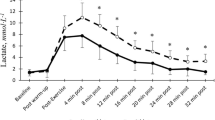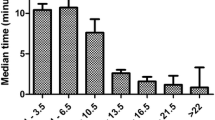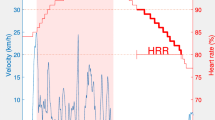Abstract
The purpose of this study was to examine the running velocities and heart rates at fixed lactate concentrations of young soccer players according to playing position and age. A total of 223 young male soccer players participated in this study. Each player performed incremental exercise tests on a treadmill. Running velocities and heart rates at 2 mmol/L−1, 2.5 mmol/L−1, 3 mmol/L−1, and 4 mmol/L−1 blood lactate concentrations were calculated with use of the spline function. Data were analyzed through analysis of variance to examine differences among various playing positions (ie, defenders, midfielders, and forwards) and 3 age groups (U17, under 17 y; U19, under 19 y; and U21, under21 y). No significant differences were discerned between defenders, midfielders, and forwards in terms of running velocities and heart rates in accordance with specified lactate concentrations. Running velocities corresponding to all lactate concentrations showed no significant differences at all age groups, but heart rates in soccer players in the U21 and U19 age groups were significantly lower than in the U17 age group. Following a 3-y trial of 20 players, running velocities increased and heart rates decreased at all corresponding lactate concentrations. Results of this study suggest that (1) the endurance performance level of young soccer players is similar for all positions, and (2) heart rates are lowered with age and with training.
Similar content being viewed by others
References
Reilly T. Energetics of high-intensity exercise (soccer) with particular reference to fatigue.J Sports Sci. 1997;15:257–263.
Reilly T, Williams AM.Science and Soccer. London: Routledge; 2003.
Capranica L, Tessitore A, Guidetti L, Figura F. Heart rate and match analysis in pre-pubescent soccer players.J Sports Sci. 2001;19:379–384.
Bangsbo J. The physiology of soccer—with special reference to intense intermittent exercise.Acta Physiol Scand. 1994;15(suppl 619):1–156.
Bangsbo J.Fitness Training in Football—A Scientific Approach. Bagsværd: HO+Storm; 1994.
Reilly T. Physiological profile of the player. In: Ekblom B, ed.Football (Soccer). London: Blackwell Scientific Publications; 1994:78–94.
Helgerud J, Engen LC, Wisløff U, Hoff J. Aerobic endurance training improves soccer performance.Med Sci Sports Exerc. 2001;33:1925–1931.
Reilly T, Bangsbo J, Franks A. Anthropometric and physiological predispositions for elite soccer.J Sports Sci. 2000;18:669–683.
Bangsbo J, Michalsik L. Assessment of the physiological capacity of elite soccer players. In: Spinks W, Reilly T, Murphy A, eds.Science and Football IV. London: Routledge; 2002:53–62.
Bangsbo J, Krustrup P, Mohr M. Physical capacity of high level soccer players in relation to playing position. In:Abstract Book of the World Congress on Science and Football V. Madrid: Gymnos Editorial Deportiva; 2003:76.
Weltman A.The Blood Lactate Response to Exercise. Champaign: Human Kinetics; 1995.
Edwards AM, Clark N, Macfadyen AM. Lactate and ventilatory threshold reflect the training status of professional soccer players where maximum aerobic power is unchanged.J Sports Sci Med. 2003;2:23–29.
Gilman MB, Wells CL. The use of heart rates to monitor exercise intensity in relation to metabolic variables.Int J Sports Med. 1993;14:339–344.
Foxdal P, Sjödin B, Sjödin A, Östman B. The validity and accuracy of blood lactate measurements for prediction of maximal endurance running capacity. Dependency of analyzed blood media in combination with different designs of the exercise test.Int J Sports Med. 1994;15:89–95.
Billat LV. Use of blood lactate measurements for prediction of exercise performance and for control of training. Recommendations for long-distance running.Sports Med. 1996;22:157–175.
Gilman MB. The use of heart rate to monitor the intensity of endurance training.Sports Med. 1996;21:73–79.
Pfitzinger P, Freeddson PS. The reliability of lactate measurements during exercise.Int J Sports Med. 1998;19:349–357.
Castagna C, Abt G, D’Ottavio S. The relationship between selected blood lactate thresholds and match performance in elite soccer referees.J Strength Cond Res. 2002;16:623–627.
Bangsbo J, Nørregaard L, Thorsø F. Activity profile of competition soccer.Can J Sport Sci. 1991; 16:110–116.
Wisløff U, Helgerud J, Hoff J. Strength and endurance of elite soccer players.Med Sci Sports Exerc. 1998;30:462–467.
Ribeiro L, Balikian P, Malachias P, Baldissera V. Stage length, spline function and lactate minimum swimming speed.J Sports Med Phys Fitness. 2003;43:312–318.
Votarelli FA, Gobatto CA, Mello MAR. Determination of anaerobic threshold in rats using the lactate minimum test.Braz J Med Biol Res. 2002;35:1389–1394.
Lindquist F, Bangsbo J. Do young soccer players need specific physical training? In:Proceedings of the Second World Congress of Science and Football. London: E&FN SPON; 1991:275–280.
Saltin B, Hartley LH, Kilbom A, Astrand I. Physical training in sedentary middle-aged and older men. II. Oxygen uptake, heart rate, and blood lactate concentration at submaximal and maximal exercise.Scand J Clin Lab Invest. 1969;24:323–334.
Tulppo PM, Mäkikallio TH, Seppänen T, Laukkanen RT, Huikuri HV. Vagal modulation of heart rate during exercise: effects of age and physical fitness.Am J Physiol. 1998;274:H424-H429.
Åstrand PO, Rodahl K.Textbook of Work Physiology. New York: McGraw Hill; 1986.
Seals DR, Taylor JA, Ng AV, Esler MD. Exercise and aging: autonomic control of the circulation.Med Sci Sports Exerc. 1994;26:568–576.
Gregorie J, Tuck S, Yamamoto Y, Hughson RL. Heart rate variability at rest and exercise: influence of age, gender, and physical training.Can J Appl Physiol. 1996;21:455–470.
Wilmore JH, Stanforth PR, Gagnon J, et al. Endurance exercise training has a minimal effect on resting heart rate: the HERITAGE study.Med Sci Sports Exerc. 1996;28:829–835.
Lambert MI, Mbambo ZH, Clair ST, Gibson A. Heart rate during training and competition for long-distance running.J Sports Sci. 1998;16:S85-S90.
Carter JB, Banister EW, Blaber AP. Effect of endurance exercise on autonomic control of heart rate.Sports Med. 2003;33:33–46.
Author information
Authors and Affiliations
Rights and permissions
About this article
Cite this article
Guner, R., Kunduracioglu, B. & Ulkar, B. Running velocities and heart rates at fixed blood lactate concentrations in young soccer players. Adv Therapy 23, 395–403 (2006). https://doi.org/10.1007/BF02850160
Issue Date:
DOI: https://doi.org/10.1007/BF02850160




